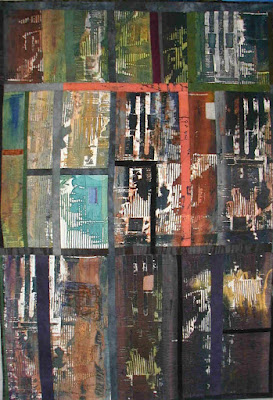 |
| One of my many York quilts... |
Many, many years ago I was employed as a librarian at Rowntrees chocolate factory in York, England.
The Rowntrees were Quakers who believed in helping their workers in many ways....they built a theatre, a swimming pool, a whole village. They also had two libraries in the factory - a wonderful old Victorian building stretch for about a half mile.
I worked in both the Lending library which had many books for all the factory employees to borrow, and in the technical library where we scanned all the daily newspapers, magazines, journals etc for articles relating to any aspect of the chocolate industry. My job was to write the "abstracts" - yes, now we come to the point of this post!! I had to read the article and then note the key points, the most outstanding and important ones, that captured the essence of the piece in a very short paragraph.
And isn't that exactly what the abstract artist does? But....how and why do they abstract?
 |
| Dark City |
As artists we're all trying to communicate, but we want to communicated something new, fresh, a diferent take on things...I think that's one of the (many) reasons abstract art became so popular. It was and is different , it's new, it gives us ways to look at things that havn't been done before....and that's very attractive. You've all heard the cliche "same old same old"..usually intoned in a very boring manner!! Well who want to makes boring art? As I looked around a small art show yesterday, I felt I had seen every image before, everything looked So stale.
I also noticed perfectly awkward (now there's a nice oxymoron for you!) compositions that just screamed at me!! well I suppose that was a striking experience - but not one I wanted! The colors also looked stale and flat...low saturation colors placed in low contrast situations are not going to look new and fresh.
When I got home I started reading the latest issue of International Artist and noticed that looking at really good art helps both to inspire and inform. The paintings were of the same subjects I'd seen in the local art show, but they were alive and fresh. One of the artists described how he had begun to feel that his work was getting stale and so he had pushed himself to seek new inspiration. Now he did it by travel, which not all of us can do in actuality, but we do it with books and the internet, by studying different kinds of art.
Look at good abstract art and be inspired by it! Try to figure out how it works. You want to learn how to compose well and satisfyingly? Then, learn from the best. Art that has stood the test of time - it's now well over hundred years since abstract art (as art) began to be produced...there's a lot to learn from!
And, if you should be interested, I am starting a new class called More Abstract Art for Quiltmakers
this Friday at www.academyofquilting.com
Take a look at your own work, or the work of other local art lovers, does it really catch your eye and give you a frisson of both awe and recognition? Or is it stale and ho-hum? And what is the difference? What are the differences between the two kinds of art? Can you work it out? Can you apply it? It's not just technique, though of course that is important...it's also being creative, being original, being prepared to try out new things, even though many will not work. Don't give yourself excuses!! Time (alas!) is short!
And, if you have been, thanks for reading......
and do please comment - what do you see as you look around at the art world around you?
Elizabeth
















